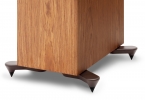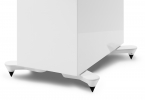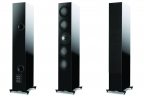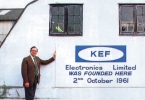KEF R11 Floor Standing Loudspeakers Review

With the release of the next-generation R Series loudspeakers from KEF, we take a closer look at the R11 which is the flagship and largest of the three floor standing models in the series.
KEF
R11
Floor Standing Loudspeakers
AUD $8,995
 While the KEF loudspeaker brand almost needs no introduction, their history is fascinating. They were launched back in 1961 in Tovil, Kent, England on the premises of the metal-working operation named Kent Engineering & Foundry and hence abbreviated to KEF.
While the KEF loudspeaker brand almost needs no introduction, their history is fascinating. They were launched back in 1961 in Tovil, Kent, England on the premises of the metal-working operation named Kent Engineering & Foundry and hence abbreviated to KEF.
Clearly, they love the location as nearly sixty years later they're still there, manufacturing KEF's Reference Series and above.
Since their early beginnings, KEF has been all about creating innovative loudspeakers using the latest in materials technology. They were one of the first manufacturers to use computers to assist in designing loudspeakers.
KEF's current speaker range consists of the limited edition statement MUON, Blade series, Reference series and then the R Series, Q Series and lastly the award-winning LS50/LSX series of models. Their ranges span both home cinema and stereo applications, as well as custom integration, commercial applications, wireless, lifestyle and lastly outdoor speakers.
KEF has a deep understanding of how to create the right loudspeaker for the proper application and as consumers and enthusiasts, where we fit into a manufacturer's model range is determined by our circumstances. How much space do we have? What equipment do we already own? What is our preferred taste in music, and how do we define an exciting or natural sounding loudspeaker? No one product is suitable for everyone as we are all on our unique musical journey. That’s why we have the freedom of choice and plenty of it.
The loudspeaker that we're taking a closer look at is the new KEF R11. Let’s try to work out if this model suits you and could potentially be the right fit. The R11 is the flagship and largest of the three floor standing models in the R series range. They sell in Australia for $8,995 a pair.

When I saw the R11’s for the first time, I was quite taken by the sheer size and weight of the units. Measured on their plinths, they are 1296mm high x 310mm wide x 380 deep and are 37.7kg each.
The review sample is finished in a beautiful gloss white and looks absolutely superb and very modern. They are also available in gloss black, and wood veneer, featuring KEF's “tone-on-tone” style which means that the driver details are colour-matched to the finish.
As all the fixings are hidden, all you see is a clean exterior which is very effective and stylish. They arrived with well-designed microfibre grilles in the box, but I thought that the R11 drivers looked so good that I didn’t want to hide them behind the grilles.
KEF uses four 165mm (6.5”) bass drivers in a bass reflex design. It’s a three-way loudspeaker with KEF's famous Uni-Q tweeter/midrange driver residing in the middle of the four bass drivers. The Uni-Q driver has the 25mm tweeter at the acoustic centre of the 125mm midrange cone so that an ideal point source array is formed.

The tweeter is made of aluminium and has a cool looking tangerine waveguide that improves its performance. The idea behind the Uni-Q driver is to achieve a blend between the two units in terms of both response and dispersion. KEF says that the two units together can be regarded as a single driver but without the performance shortfall that would be suffered by a true single driver covering such a wide frequency range.
When I mentioned that the R11’s are new, this generation of R series features new cabinets, all new drivers, and benefits from technology and innovation that has trickled down from the far more expensive Reference & Blade projects.
For instance, the Uni-Q driver used in the R11 is now in its 12th generation, with refinements still being found and implemented.
KEF has continued its use of sophisticated computer modelling techniques, such as finite element analysis and computational fluid dynamics in the design of their loudspeakers. KEF's whitepapers (available online) describe the design philosophy and methodology of achieving their stated objectives. It’s too detailed for this review, so I'd recommend that anyone interested have a read for themselves. The results of all of that applied technology seem to be comprehensive and impressive, with a thoroughly modern loudspeaker design that was begging to be heard. Why resist?

Listening
I hooked a single pair of quality speaker cables to the LF dual binding posts of the R11’s and used the “Link” dial to join the high and low frequencies together, a very worthy inclusion to the KEFs. After a bit of experimentation with the positioning and toe-in (which ended up in a similar position to most other speakers I review), I was greeted with a vast soundstage that surprised me.
The music filled the entire room with a spaciousness that at first sounded a touch foreign due to the driver arrangement and the sheer size of the loudspeakers. Even though they stand 1.3m tall, their slim profile and smooth minimalist finish allow them to blend into a room very easily and look quite inconspicuous. But when you play music through them, all the benefits of a large loudspeaker are there, including scale, drive and the effortless of moving large amounts of air. They just sound big!
There is a direct correlation with the size of the loudspeaker cabinet and the cone area to how ‘large’ music can sound. Generally, the larger they are, the greater the feeling of physicality and scale. Even though a small bookshelf loudspeaker can produce a large sound stage, there is nothing that can compare to much larger enclosures. As they say in the car world “there is no substitute for cubic inches”.

So with that in mind, I was drawn to listening to big and dynamic music. Gary Numan is a long-time favourite, so I cued up “Broken”, the last track from the Savage album. The track starts quietly and builds. The R11’s really nailed the metallic quality of the synthesiser with plenty of detail, clarity and realism. The track sounds big, and these loudspeakers played it the way that it should be, with grace, gusto and impact. The scale of the soundstage was staggeringly large with Gary’s voice hanging in space with everything going on around him.
With four bass drivers and 90dB/2.83V/1m efficiency, there is a tonne of energy able to be generated with minimal effort required. Next up was Doug MacLeod's “My Black Pony” from his Whose Truth, Whose Lies? blues album released in 2000. It’s an old favourite of mine, and I enjoyed the hand taps and kick drum thumps. The R11’s were able to nicely define all the instruments and give them their own space and energy. They seemed to thrive when played at high volume levels, and without the slightest stress or compression.
The following track on the album “Saint Louis On My Mind” has some big dynamic swings and all the slam and impact comes through impressively.
With a 300W Perreaux amplifier driving them, the R11’s lapped up pretty much anything that I could find to play, but I think that they sounded their best with dynamic music, especially when it has been well recorded.

“State of the Art” by Gotye has a big sound (which seems to be the theme of the day), and despite lots of sounds and dubs, the R11’s were able to define all of the layers and return a satisfyingly large soundstage bolstered by plenty of thump in the bottom end. While perhaps not the last word in deep bass extension, they can undoubtedly deliver tight, coherent bass, and plenty of it, at almost any volume setting.
Simple Minds' “Hunter and the Hunted” is an old classic track that is a go-to track for slam and tight, punchy kick drum bass. The track was recorded quite softly, so is begging to have the volume dial cranked. The big KEF’s just loved giving a physical delivery to this track. Visceral slam, thump and kick that can be felt as well as heard. The louder you wanted it, the better it sounded. They seemed to be limitless. As such I can imagine that they could readily be enjoyed with friends when entertaining, and cranked to 11 when listening to old rock anthems.
On top of all of that, they also image incredibly well. The Uni-Q driver is responsible, and I can now understand what all the fuss is with this driver. The majority of detail of any track is in the midrange and treble region. The construction of the Uni-Q driver must be incredibly complex, and the fact that it's now in its 12th generation it's no small feat for any manufacturer.

There is togetherness in the sound of everything above the bass notes that is unique to KEF loudspeakers that use this driver that is difficult to explain in words. It took me a few minutes to get used to its sound, as it’s slightly different having the mid and treble coming from what seems a single point source. But it works well, and it contributes to the big cohesive sound that the loudspeaker generates.
As the Uni-Q driver is in the centre of the four bass drivers, they all integrate very well in sending sweet music into the listening room. It's positioned approximately 750mm from the floor, and I can't help but feel I would prefer the Uni-Q driver slightly higher up and closer to ear level. But it really didn’t matter as the off-axis response from the R11’s is very good, with a large sweet spot for listening from.
Some tracks were slightly bright in their presentation, with instruments like brass, strings and cymbals sounding a tad emphasised. The upside though is that this added air, crispness and life to them or what I refer to as added 'sparkle', which may or may not be to your taste.

Conclusion
Are the KEF R11’s the right fit for you? I'd suggest discussing this with your local specialist, as KEF also offer the smaller R7, R5 and R3 models that may be a more suited fit for your specific room. They all have the same technology and stunning aesthetics. One size certainly does not fit all.
I can categorically state that the new KEF R series is exceptionally well made and represents excellent value for money. The overall level of finish and the attention to detail is outstanding, and amongst the best I‘ve seen at any price.
They are certainly a technological tour de force with cutting edge design, and intelligent use of materials and the benefit of KEF’s obvious R&D budget is clear to see (and hear).
KEF's R11 loudspeakers sing when played loudly, rather than softly. They enjoy bigger, more powerful amplifiers and deliver raw energy without raising a sweat.
The R11’s have been a ton of fun to listen to and have given me some very wide smiles indeed.
For more information visit KEF.
Mark Gusew
Starting his first audio consultancy business in the early ’80s whilst also working professionally in the electronics industry, Mark now splits his time between professional reviewing and AV consultancy.
Posted in:Hi-Fi Loudspeakers Floor Standing
Tags: kef advance audio
JOIN IN THE DISCUSSION
Want to share your opinion or get advice from other enthusiasts? Then head into the Message Forums where thousands of other enthusiasts are communicating on a daily basis.
CLICK HERE FOR FREE MEMBERSHIP
Trending
applause awards
Each time StereoNET reviews a product, it is considered for an Applause Award. Winning one marks it out as a design of great quality and distinction – a special product in its class, on the grounds of either performance, value for money, or usually both.
Applause Awards are personally issued by StereoNET’s global Editor-in-Chief, David Price – who has over three decades of experience reviewing hi-fi products at the highest level – after consulting with our senior editorial team. They are not automatically given with all reviews, nor can manufacturers purchase them.
The StereoNET editorial team includes some of the world’s most experienced and respected hi-fi journalists with a vast wealth of knowledge. Some have edited popular English language hi-fi magazines, and others have been senior contributors to famous audio journals stretching back to the late 1970s. And we also employ professional IT and home theatre specialists who work at the cutting edge of today’s technology.
We believe that no other online hi-fi and home cinema resource offers such expert knowledge, so when StereoNET gives an Applause Award, it is a trustworthy hallmark of quality. Receiving such an award is the prerequisite to becoming eligible for our annual Product of the Year awards, awarded only to the finest designs in their respective categories. Buyers of hi-fi, home cinema, and headphones can be sure that a StereoNET Applause Award winner is worthy of your most serious attention.


_cmyk__thumbnail_gallery_image.jpg)










